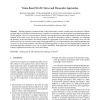Free Online Productivity Tools
i2Speak
i2Symbol
i2OCR
iTex2Img
iWeb2Print
iWeb2Shot
i2Type
iPdf2Split
iPdf2Merge
i2Bopomofo
i2Arabic
i2Style
i2Image
i2PDF
iLatex2Rtf
Sci2ools
IJCV
2007
2007
Vision-Based SLAM: Stereo and Monocular Approaches
Building a spatially consistent model is a key functionality to endow a mobile robot with autonomy. Without an initial map or an absolute localization means, it requires to concurrently solve the localization and mapping problems. For this purpose, vision is a powerful sensor, because it provides data from which stable features can be extracted and matched as the robot moves. But it does not directly provide 3D information, which is a difficulty for estimating the geometry of the environment. This article presents two approaches to the SLAM problem using vision: one with stereovision, and one with monocular images. Both approaches rely on a robust interest point matching algorithm that works in very diverse environments. The stereovision based approach is a classic SLAM implementation, whereas the monocular approach introduces a new way to initialize landmarks. Both approaches are analyzed and compared with extensive experimental results, with a rover and a blimp.
| Added | 19 Dec 2010 |
| Updated | 19 Dec 2010 |
| Type | Journal |
| Year | 2007 |
| Where | IJCV |
| Authors | Thomas Lemaire, Cyrille Berger, Il-Kyun Jung, Simon Lacroix |
Comments (0)

